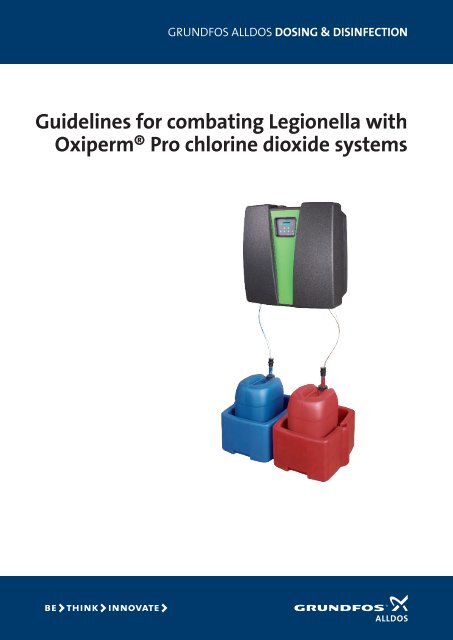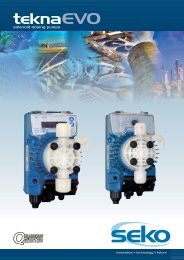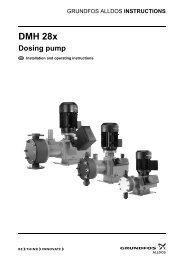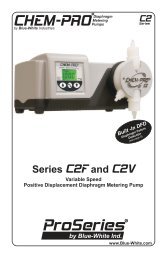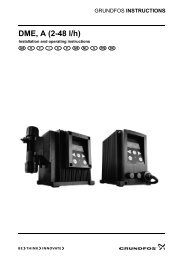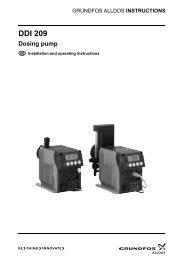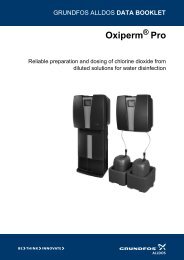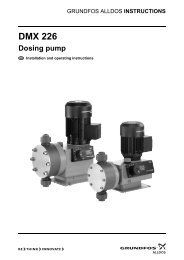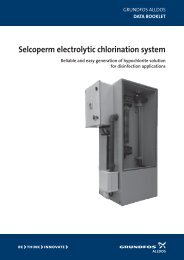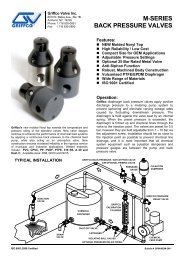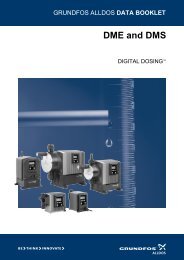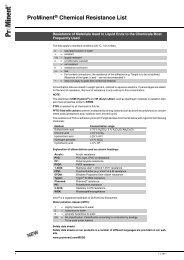guidelines for combating Legionella with oxiperm® Pro ... - Grundfos
guidelines for combating Legionella with oxiperm® Pro ... - Grundfos
guidelines for combating Legionella with oxiperm® Pro ... - Grundfos
Create successful ePaper yourself
Turn your PDF publications into a flip-book with our unique Google optimized e-Paper software.
GRUNDFOS alldos Dosing & DISINFEcTIONGuidelines <strong>for</strong> <strong>combating</strong> <strong>Legionella</strong> <strong>with</strong>Oxiperm® <strong>Pro</strong> chlorine dioxide systems
BasicsWhere are <strong>Legionella</strong> found?<strong>Legionella</strong> are found naturally in the microflora of river, lake and ground water, albeit usually in small quantities. Conditionsthat encourage the growth of <strong>Legionella</strong> include water temperatures of between 20 and 50 °C and a food source – particularlyother biological substances or deposits such as rust or limescale. <strong>Legionella</strong> travel via intakes from surface water intothe drinking water network prior to water treatment in waterworks.Generally, hot water systems <strong>with</strong> a low flow rate, areas of stagnation, orbadly serviced boilers offer ideal conditions <strong>for</strong> the growth of <strong>Legionella</strong>. <strong>Legionella</strong>reproduce abundantly in a temperature range of between 30 and50 °C and live in biofilms where they are shielded against most chemicaldisinfectants and all disinfection technologies that do not use chemicals.A biofilm consists mainly of mixed colonies of micro-organisms (bacteria, algae,fungi, protozoans) that are connected to one another but attached to asingle substrate and integrated fully or partially in a polymeric organic mass(slime) – an extracellular polymeric substance (EPS) – produced by the organism.This gel-like film offers ideal conditions – namely food and protection– <strong>for</strong> the permanent contamination of drinking or process water <strong>with</strong>pathogenic micro-organisms such as pseudomonads, fungi, mycobacteria,viral pathogens and particularly <strong>Legionella</strong> bacteria.Figure 3: <strong>Legionella</strong> in a biofilm<strong>Legionella</strong> also reproduce in their thousands in amoebae, which function as hostbodies be<strong>for</strong>e being discharged from the biofilm by water flow. If these amoebaeare then rinsed out through the aerator of a shower head or tap, the drop in pressurecauses the host body to burst, releasing tens of thousands of <strong>Legionella</strong>. Theaerosols are then inhaled by people, <strong>with</strong> the above-mentioned consequences.Figure 4: Hartmannella vermi<strong>for</strong>mis amoebae filled <strong>with</strong><strong>Legionella</strong> pneumophilaWhen both factors are present – conditions that encourage the growth of <strong>Legionella</strong> and the <strong>for</strong>mation of inhalable aerosols<strong>with</strong> a water droplet size of between 3 and 5 µm – the following systems are potential sources of risk:• Hot and cold water supplies through taps and showers in private households, hotels, retirement homes, sports facilities,etc.• Water systems incorporating a cooling tower• Water systems incorporating an evaporator• Air-conditioning units or humidifiers• Other facilities and systems that transport water at temperatures that can exceed 20 °C and disperse water vapour whenbeing used or serviced. Examples include whirlpools, spa baths, small decorative fountains and paint spray booths.
Laws and <strong>guidelines</strong>What are the responsibilities of those operating water supply installations?International organisations, laws and <strong>guidelines</strong>:• The WHO (World Health Organisation) “Guidelines <strong>for</strong> Drinking Water Quality“ (2004)• The WHO “Guidelines <strong>for</strong> Safe Recreational Water Environments“ (2006)• The WHO “Guide to Ship (and Hotel) Sanitation“ (2007)European organisations, laws and <strong>guidelines</strong>:The Council of the European Union guideline 98/83 EC “Quality of water intended <strong>for</strong> human consumption”• The EWGLI (European Working Group <strong>for</strong> <strong>Legionella</strong> Infections ) “European Guidelines <strong>for</strong> Control and Prevention ofTravel Associated Legionnaires’ Disease“ 2119/98/ECThe CDC (Center <strong>for</strong> Disease Control USA):• The HICPAC (Healthcare Infection Control Practices Advisory Committee) “Guidelines <strong>for</strong> Environmental Infection Controlin Healthcare Facilities“In Germany, legal principles are primarily set out in:1) The German Federal law <strong>for</strong> the prevention and <strong>combating</strong> of infectious diseases in humans – IfSG (Infection <strong>Pro</strong>tectionAct)2) The German Drinking Water Ordinance regulating the quality of water intended <strong>for</strong> human consumption§37 of the IfSG states: Water intended <strong>for</strong> human consumption must be supplied in such a way that its consumption oruse will not adversely affect human health, especially through means of a pathogen.Pathogens that must be reported by law include <strong>Legionella</strong> (IfSG §§ 6, 7).Owners or operators of water systems in public or residential buildings have full responsibility <strong>for</strong> the quality of the watersystems right up to the water outlet.Public health authorities are required to inspect water supply installations that distribute water <strong>for</strong> the general public. TheDrinking Water Ordinance stipulates that water providers and public facilities regularly test water quality. Tests also needto be carried out periodically to check <strong>for</strong> the presence of <strong>Legionella</strong> in central heating facilities of the plumbing installation.If these test results are positive, operators, planners and technicians are called together to discuss remedial measures. Publichealth authorities are authorised to order the closure of water supply installations if specified limit values are exceeded.Non-compliance <strong>with</strong> regulations is punishable in several countries.• In consequence of non-compliance <strong>with</strong> regulations (intentional or negligent) a fine or a jail sentence can be imposedIf such penalties are to be avoided, it is important that bacterial contamination is effectively eradicated and that betterpreventive treatment is applied to the installation system.
Comparison of the methodsWhat methods are used to combat <strong>Legionella</strong>?The methods and their propertiesThermal treatmentThe most commonly used method of <strong>combating</strong> <strong>Legionella</strong> isthermal disinfection.<strong>Legionella</strong> begin to die off at temperatures above 60 °C,which makes it possible to combat the bacteria by heatingthe infected water system.UV radiationNo chemicals are used.Sufficient protection can be provided when levels of bacterialcontamination in the water are low.FiltrationMicrofilters or membrane filters can screen bacteria, viruses,suspended particles and other unwanted elements from thewater.Hypochlorite solutionEffective alternatives include disinfectants that combat bothpathogens and the biofilm. Chlorine is often used as a disinfectantin the <strong>for</strong>m of a hypochlorite solution that is addedto the installation system.Disadvantages• A temperature of approximately 70 °C must be reached and maintainedthroughout the entire piping system over a period of several minutes. However,this can seldom be achieved in typical installations because the water coolsdown as it reaches the water outlets.• Not all water outlets are accessible (e.g. in residential buildings).• Acute risk of scalding if the water outlets are readily accessible.• Increased limescale deposits that damage systems.• Thermal expansion can cause irreparable damage and leakages in older installations.• The biofilm containing germs is unaffected, <strong>with</strong> the result that germs alwaysbuild up again between treatment cycles.• When levels of <strong>Legionella</strong> contamination are high, this method does not sufficientlykill off bacteria and additional shock treatment <strong>with</strong> chlorine and chlorinedioxide is also necessary.• Relatively large units are required to generate a sufficient intensity of UV light.Furthermore, if the <strong>Legionella</strong> are not killed off completely, the entire procedurewill have been unsuccessful.• The biofilm in the piping networks – the basis <strong>for</strong> the multiplication of <strong>Legionella</strong>– is unaffected by this procedure.• Insufficient protection against <strong>Legionella</strong> and other micro organisms that cancontaminate piping from the tap connections.• No affect on the biofilm.• <strong>Legionella</strong> are far more resistant to chlorine than many other bacteria such asEscherichia coli. Experiments have shown that chlorine needs to act 40 timeslonger on <strong>Legionella</strong> than on E. coli to achieve the same level of fatality on the<strong>Legionella</strong> population.• Only free <strong>Legionella</strong> are affected because the biofilm is not penetrated or brokendown. With a chlorine surplus of at least 2 ppm in pipe networks <strong>with</strong> biofilms,the number of <strong>Legionella</strong> can be kept below the tolerance level of 100CFU (colony-<strong>for</strong>ming units) per 100 ml.Why is chlorine dioxide the method of choice?Chlorine dioxideChlorine dioxide is becoming an increasingly popular disinfectant<strong>for</strong> <strong>combating</strong> <strong>Legionella</strong>.Benefits• Chlorine dioxide has a far more effective disinfecting action than identical concentrationsof chlorine.• Greater sustained-release effect <strong>for</strong> longer lasting disinfection.• Selective effect, i.e. toxic chloramines or halo<strong>for</strong>ms (THM) are not <strong>for</strong>med andthe smell and taste of the water are unaffected.• A key benefit of chlorine dioxide is that it attacks and destroys both free pathogensand the biofilm.
Chlorine dioxideWhy is chlorine dioxide the method of choice?Chlorine dioxide is gas, which is yellowish orange in colour, has an ozone-like odour and is highly soluble in water. Thechemical and biochemical effects are based on the conversion to chlorite during the disinfection process and reduction tochloride through purely chemical degradation processes.Chlorine dioxide cannot be stored andthere<strong>for</strong>e has to be produced at the locationwhere it is to be used.Because of its high redox potential, chlorinedioxide has a much more powerfuldisinfecting action against all kinds ofgerms and contaminants such as viruses,bacteria, fungi and algae thanother biocides. The oxidation potentialis higher than <strong>with</strong> chlorine, <strong>for</strong> example,so that far fewer chemicals arerequired. The longer dwell time is alsoparticularly advantageous due to theselective disinfection. Even germs thatare resistant to chlorine, <strong>for</strong> example<strong>Legionella</strong>, can be killed completely bychlorine dioxide. Special measures needto be taken to combat them since theycan adapt to conditions that are fatal tomany organisms and are, <strong>for</strong> the mostpart, resistant to biocides.Residual germs [%]100806040200residualgerms<strong>with</strong> CIO 2residual germs<strong>with</strong> HCIO0.01 0.02 0.03 0.04 0.05 0.06Concentration of disinfectant [mg/l]Figure 5:Comparison of the disinfecting action of chlorine dioxide and chlorine at a pH level of >7.5The major difference between chlorine dioxide and chlorine or hypochlorite is the gradual effect it has on degrading biofilmat low doses. A concentration of 1 ppm will kill virtually all <strong>Legionella</strong> in the biofilm <strong>with</strong>in 18 hours. A marked reduction inthe biofilm can be achieved <strong>with</strong>in the same time <strong>for</strong> a concentration of 1.5 ppm. Furthermore, the disinfecting action ofchlorine dioxide is virtually independent of the pH value, meaning that it can also be used <strong>with</strong>out any problems in alkalineenvironments..How is the application of chlorine dioxide regulated <strong>for</strong> the drinking water disinfection?Generally, the addition of a maximum quantity between 0.2 and 0.8 mg/l is permissible. The addition of chlorine dioxide todrinking water must be carried out in proportion to the amount of water. Dosing must be carefully regulated and must notbe carried out manually.In case of concentration-controlled dosing into a closed water circuit, there is a risk from the concentration of the by-productsto rise above the admissible limit value.
InstallationWhat installation variants are available?Legend <strong>for</strong> the following installation variants:1. Main water pipe2. Dilution water extraction point3. Dilution water pipe4. Flow measurement5. Injection unit6. Dosing line7. Dosing pump <strong>for</strong> sodium chlorite8. Dosing pump <strong>for</strong> hydrochloric acid9. Dosing pump chlorine dioxide10. Reaction tank11. Chlorine dioxide storage tank12. Control unit incl. measuring amplifier and display <strong>for</strong> chlorine dioxide measuring cell13. Solenoid valve <strong>for</strong> dilution water14. Activated carbon filter <strong>for</strong> reaction tank deaeration15. Sodium chlorite tank <strong>with</strong> catchment tray16. Hydrochloric acid tank <strong>with</strong> catchment tray17. Measuring water extraction point18. Measuring water pipe19. Chlorine dioxide measuring cell20. Tapping clamp21. Mixing module22. Measuring module23. Second ClO 2dosing pump24. Dirt trap
Installation1) One dosing pointIt is usually sufficient <strong>for</strong> the chlorine dioxide solution to be added to a plumbing installation at a single point. This is usuallythe hot water system <strong>with</strong>in the plumbing installation.Variant A1With this variant, chlorine dioxide is added directly to the main water pipe via an injection point or static mixer.Variant B1It is recommended that the <strong>Grundfos</strong> Alldos bypass moduleis used. Pipes do not need to be opened when using this variant,which means that the water flow does not need to beinterrupted. Bypass water is removed and returned via tappingclamps. Chlorine dioxide is added in an injection pointin the module. As a result, premixed disinfectant is added tothe water flow and the risk of corrosion is minimised. Anotherbenefit is the straight<strong>for</strong>ward fitting <strong>with</strong>out interrupting thewater supply, which saves both time and money.Figure 9: Connecting the Oxiperm <strong>Pro</strong> chlorine dioxide production system tothe main water pipe via the bypass module
Installation2) Two dosing pointsIn many building installations, hot and cold water circuits are located close together or are insufficiently insulated. This canmean that cold water pipes also become contaminated <strong>with</strong> germs. In such cases, it is advisable to use Oxiperm® <strong>Pro</strong> <strong>with</strong>two dosing points – one <strong>for</strong> hot and one <strong>for</strong> cold water. This is possible when the total volumetric flow does not exceed 12m³/h (system <strong>with</strong> 5g/h) or 24 m³/h (system <strong>with</strong> 10 g/h). In other cases, two separate systems need to be installed.Just as when a single dosing point is used, it is also possible either to add the dose directly into the installation or use the <strong>Grundfos</strong>Alldos bypass module.Variant A2: Direct dosingFigure 10: Connecting the Oxiperm® <strong>Pro</strong> chlorine dioxide production systemdirectly to the hot and cold water systemVariant B2: BypassFigure 11: Bypass connection of the Oxiperm® <strong>Pro</strong> chlorine dioxide productionsystem directly to the hot and cold water system10
DecontaminationHow can it be ensured that decontamination is successful?When <strong>Legionella</strong> is discovered <strong>with</strong> CFU (colony-<strong>for</strong>ming units) of < 1000 per 100 ml, decontamination can be carried out byadding chlorine dioxide directly into the pipe network.CFU of > 1000 / 100 ml often indicate increased biofilm growth. In these cases, the installation system should be thoroughlycleaned either chemically or mechanically be<strong>for</strong>e chlorine dioxide is added.In all cases, a meeting should be sought <strong>with</strong> the relevant health authority, the building operator and/or building owner.The cause of high levels of <strong>Legionella</strong> is usually found in the building installation itself. Several factors besides chemicaldisinfection can help ensure decontamination is successful:• Improving the circulation of water• Fixing broken or blocked pipes• Separating fire protection systems from drinking water• etc.Precautionary installation vs. the minimisation ruleThe guiding principle <strong>for</strong> keeping drinking water installations safe and germ-free is “use as many chemicals as necessary butas few as possible”. Precautionary disinfection is particularly recommended <strong>for</strong> sensitive locations such as drinking watersupplies <strong>for</strong> hospitals, retirement homes, hotels and similar facilities.An investigation carried out by the German health authorities revealed that, between 2004 and 2006, concentrations of<strong>Legionella</strong> that exceeded the permissible tolerance value (100 CFU / 100 ml) were found in approximately 30 % of watersamples that were tested (from hospitals, retirement homes, hotels). This indicates the high level of risk to which inhabitantsare exposed. As a result, some regions in Germany have since made the installation of disinfection systems a legalrequirement <strong>for</strong> hospitals and retirement homes.The various benefits of chlorine dioxide over alternative procedures enable discrete disinfection, using extremely low concentrationsto ensure effective protection <strong>for</strong> inhabitants while avoiding high decontamination costs and preventing theclosure of buildings.11
Being responsible is our foundationThinking ahead makes it possibleInnovation is the essenceSubject to change.© <strong>Grundfos</strong> AlldosDosing & Disinfectionwww.grundfosalldos.com


